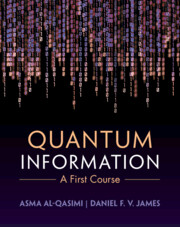Refine search
Actions for selected content:
772 results in Computer Hardware, Architecture and Distributed Computing
Computer Networks
- An Algorithmic Approach
- Coming soon
-
- Expected online publication date:
- July 2026
- Print publication:
- 01 May 2027
-
- Textbook
- Export citation

Parallel Computer Organization and Design
- Coming soon
-
- Expected online publication date:
- January 2026
- Print publication:
- 09 October 2025
-
- Textbook
- Export citation

Quantum Information
- A First Course
-
- Published online:
- 17 October 2025
- Print publication:
- 26 June 2025
-
- Textbook
- Export citation

Basic Computation and Programming with C
-
- Published online:
- 17 July 2025
- Print publication:
- 24 May 2016
-
- Textbook
- Export citation
Index
-
- Book:
- Quantum Information
- Published online:
- 17 October 2025
- Print publication:
- 26 June 2025, pp 298-302
-
- Chapter
- Export citation
Solutions to Select Exercises
-
- Book:
- Quantum Information
- Published online:
- 17 October 2025
- Print publication:
- 26 June 2025, pp 237-273
-
- Chapter
- Export citation
Appendix A - Derivatives and Differential Equations
-
- Book:
- Quantum Information
- Published online:
- 17 October 2025
- Print publication:
- 26 June 2025, pp 274-275
-
- Chapter
- Export citation
Appendix D - Haar-Distributed Random Unitary Matrices
-
- Book:
- Quantum Information
- Published online:
- 17 October 2025
- Print publication:
- 26 June 2025, pp 281-281
-
- Chapter
- Export citation
7 - Realizations of Qubits: Examples
-
- Book:
- Quantum Information
- Published online:
- 17 October 2025
- Print publication:
- 26 June 2025, pp 139-164
-
- Chapter
- Export citation
Appendix C - Probabilities and Probability Distributions
-
- Book:
- Quantum Information
- Published online:
- 17 October 2025
- Print publication:
- 26 June 2025, pp 279-280
-
- Chapter
- Export citation
8 - The Physics of Two-Qubit Gates
-
- Book:
- Quantum Information
- Published online:
- 17 October 2025
- Print publication:
- 26 June 2025, pp 165-176
-
- Chapter
- Export citation
2 - Quantum Mechanics for Quantum Computers
-
- Book:
- Quantum Information
- Published online:
- 17 October 2025
- Print publication:
- 26 June 2025, pp 18-50
-
- Chapter
- Export citation
4 - Quantum Algorithms
-
- Book:
- Quantum Information
- Published online:
- 17 October 2025
- Print publication:
- 26 June 2025, pp 78-100
-
- Chapter
- Export citation
Appendix B - Singular Value Decomposition
-
- Book:
- Quantum Information
- Published online:
- 17 October 2025
- Print publication:
- 26 June 2025, pp 276-278
-
- Chapter
- Export citation
Suggestions for Further Reading
-
- Book:
- Quantum Information
- Published online:
- 17 October 2025
- Print publication:
- 26 June 2025, pp 293-297
-
- Chapter
- Export citation
3 - Two Qubits and Entanglement
-
- Book:
- Quantum Information
- Published online:
- 17 October 2025
- Print publication:
- 26 June 2025, pp 51-77
-
- Chapter
- Export citation
9 - Device Characterization
-
- Book:
- Quantum Information
- Published online:
- 17 October 2025
- Print publication:
- 26 June 2025, pp 177-192
-
- Chapter
- Export citation
6 - Realizations of Qubits: General Discussion
-
- Book:
- Quantum Information
- Published online:
- 17 October 2025
- Print publication:
- 26 June 2025, pp 124-138
-
- Chapter
- Export citation
Glossary
-
- Book:
- Quantum Information
- Published online:
- 17 October 2025
- Print publication:
- 26 June 2025, pp 282-292
-
- Chapter
- Export citation
Appendices
-
- Book:
- Quantum Information
- Published online:
- 17 October 2025
- Print publication:
- 26 June 2025, pp 274-281
-
- Chapter
- Export citation
